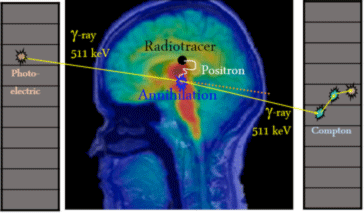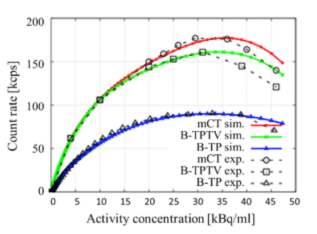Accurate reconstruction methods in PET require the use of realistic models of the emission, transmission and detection of the specific radiation used to scan the patient. In the case of PET, the complexity of the processes that occur between the emission of a positron from a radionuclide administered to the patient and the detection in coincidence of the two annihilation gamma rays in the PET scanner requires sophisticated simulation tools to reproduce them accurately. Monte Carlo (MC) techniques allow modelling all these processes and provide information that can be used to improve reconstruction methods, and also to optimize acquisition protocols, and investigate new approaches to PET imaging.
In 2009, at the Nuclear Physic group of UCM, we developed PeneloPET, a MC code for PET which has been extensively tested against preclinical and clinical scanners and it is publicly available (http://nuclear.fis.ucm.es/penelopet). It has significant advantages respect to other MC codes, especially because it is very fast, easy to install and to use. PeneloPET allows modelling different existing scanners, taking into account all the relevant as well as evaluate new acquisition protocols, experiments and detector configurations.
In 2009 Samuel España defended his PhD thesis (download) on the development of PeneloPET and its validation with preclinical PET scanners. A few years later, Khaled Abushab defended his thesis (download) on the validation of PeneloPET with clinical PET scanners.
Several international groups have started using it for their research. The last version of PeneloPET was released on spring 2017.
 
Figure (Left) Scheme of the main physical processes that need to be considered in PET for obtaining accurate results. (Right) Simulations (sim)with PeneloPET obtain very good agreement with experimental data (exp) from three different clinical PET scanners [3].
REFERENCES:
a. S. España, J.L. Herraiz, E. Vicente, J.J. Vaquero, M. Desco, J.M. Udias. PeneloPET, a Monte Carlo PET simulation tool based on PENELOPE: Features and Validation, Physics in Medicine and Biology, 2009; 54: 1723-1742. PMID: 19242053
b. J Cal-González, J. L. Herraiz, S España, P M G Corzo, J J Vaquero, M Desco and J M Udias. Positron range estimations with PeneloPET. Physics in Medicine & Biology 2013; 58: 5127. PMID: 23835700
c. K. M. Abushab, J. L. Herraiz, E. Vicente, J. Cal-González, S. España, J. J. Vaquero, B. W. Jakoby and J. M. Udías. Evaluation of PeneloPET simulations of Biograph PET/CT scanners. IEEE Trans. Nuclear Science, 2016; 63(3): 1367 – 1374.
DOI: 10.1109/TNS.2016.2527789
|

